The Philodendron Black Knight is an amazing Philodendron with dark burgundy heart-shaped foliage that almost appears black, hence the name.
Learn how to care for the Philodendron Black Cardinal in this houseplant guide.
Philodendron Black Knight Overview
A very original member of the Araceae family, the Philodendron Black Cardinal exists in both climbing and non-climbing varieties.
Black Knight climbers will look great in any room, creating aerial roots to assist in their movement upwards. They will require the support of poles or trellises for their climbing.
The non-climbing Philodendron Black Knight will grow into immense plants and feature dark green, deeply lobed leaves. They can grow into large plants, so they are more adapted to larger spaces.
They need average warmth and require little water, making them a low-maintenance houseplant. These are popular types of philodendrons for their stunning appearance and deeply tinted foliage.
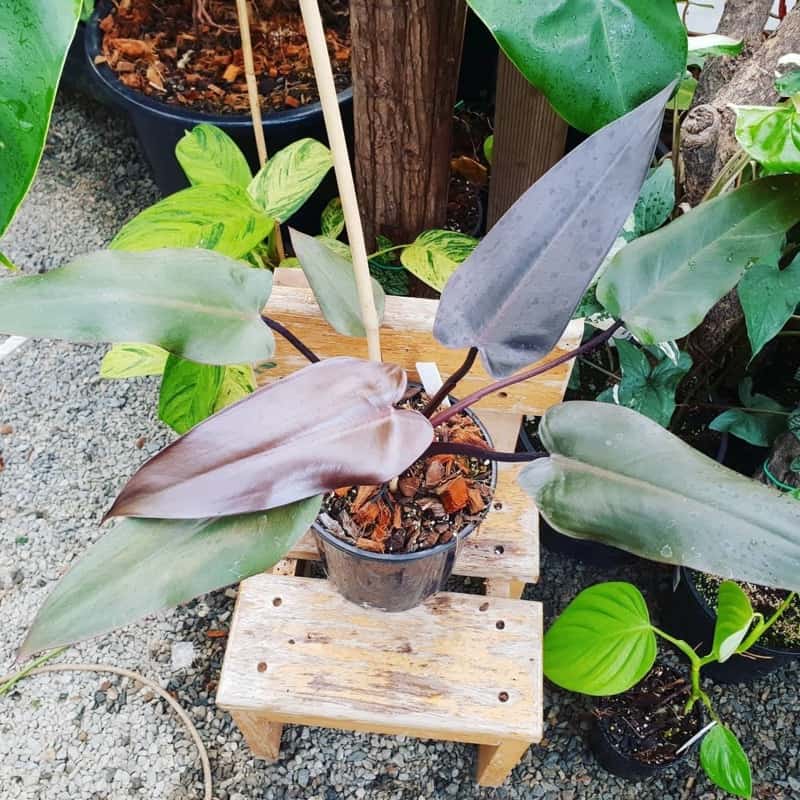
Philodendron Black Knight Care Guide
The Black Cardinal is a highly attractive perennial. This philodendron makes for a beautiful potted houseplant or it can be cultivated as an understory plant in an outdoor garden.
The best time for planting is in March. It loves partial shade and will ask for very little care and maintenance while adding a stunning conversation piece to any décor.
Soil for the Philodendron Black Knight
The soil for the Black Knight needs to be well-draining soil, while retaining moisture. A nutritious soil bed will aid the health of this plant. A light, loose, nutritious soil rich in organic matter with excellent drainage is ideal.
Philodendron Black Knights are susceptible to root rot when overwatered, so well-aerated soil is crucial to plant health. Amend a high-quality potting soil with one part peat moss for moisture retention and one part perlite for excess water drainage. Sand can also be used to ensure drainage.
The plant’s soil pH level should be acidic to neutral and can measure between 5.0 and 7.0.
Light for the Philodendron Black Knight
The Black Knight requires shade and is happiest in medium-light conditions. It will do well in bright light as long as it is indirect sunlight.
If you place it near a window, make sure that the sun’s rays don’t shine directly on the almost black Black Knight leaves. If this philodendron receives too much light, its dark-hued foliage will start to turn yellow.
Should your Black Knight become leggy with exceptionally long stems, it was probably the victim of insufficient light.
When planting outside, this is an understory plant, so look for a location that does not have direct sunlight exposure.
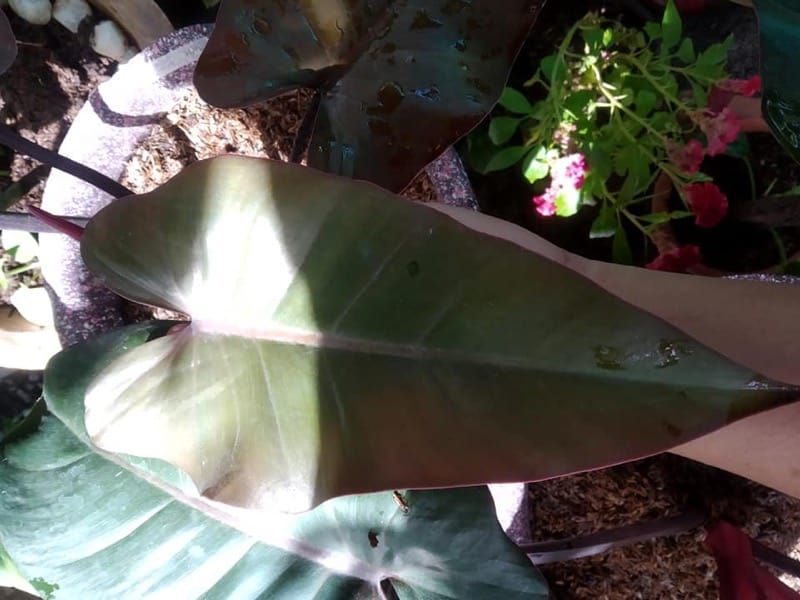
Water and Humidity for the Philodendron Black Knight
The general rule for your Philodendron Black Knight is that it needs little water. Deep watering will probably be a better solution so that the entire root system has access to it.
After soaking your plant, leave it for the excess water to drain out completely. If your plant requires it, weekly watering should suffice, perhaps a bit more in the summer depending on where you live.
Allow the soil bed surface to dry out up to two inches before watering. You can test the soil by sticking your finger into the top two inches of soil to test the moisture level.
When philodendrons have droopy leaves, it will most likely be due to a water issue, either overwatering or underwatering.
Like all native tropical plants, the Philodendron Black Knight will grow best in warm conditions and a humid environment. While it may not need rain, it also will not do well in dry spaces, especially for lengthy periods.
Average humidity levels found in homes will work, but ideally, the humidity level needs to measure between 60% to 70%. Humidity aids in keeping the Philodendron Black Knight’s black leaves well-hydrated.
If your plant’s location is dry, you can modify this by increasing the humidity near where your plant is located. Simple methods for increasing humidity are:
- Creating a pebble tray.
- Turning on a humidifier.
- Misting your plant regularly.
- Grouping plants near one another for natural transpiration.
Temperature for the Philodendron Black Knight
As a tropical, the Philodendron Black Knight will not tolerate temperatures that dip below 55°F. Average room warmth will be fine for this plant. Remember, if you are comfortable, your plant will be as well.
This is not a frost-hardy plant, so be sure to avoid cold temperatures and cold drafts.
Fertilizer for the Philodendron Black Knight
A monthly feeding with a balanced NPK 20-20-20 fertilizer during the growing season and a feeding every two months in the winter will suffice.
To avoid root burn, apply fertilizer diluted to half-strength. If the leaf color begins to blanch and turn pale, feed your plant.
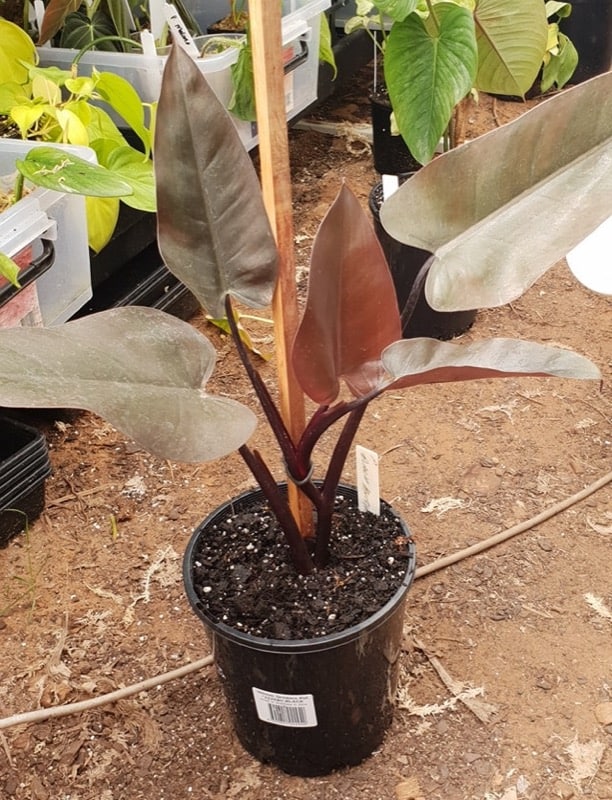
Pruning the Philodendron Black Knight
Trailing or climbing philodendrons will need pruning because its aerial roots will attach to anything they come into contact with, including your walls.
If vines begin to look leggy, you should trim them. Dead, dying or damaged leaves should also be removed to allow healthy, newborn leaves to grow.
Repotting the Philodendron Black Knight
An annual repotting is recommended because the Philodendron Black Knight tends to grow rather quickly. Climbing philodendrons will be easier to repot after pruning.
Both pruning and repotting should be done preferably in the spring. When repotting, select a container one size larger with a sufficient number of drainage holes.
Propagating the Philodendron Black Knight
If you want to propagate your Black Knight, do so in the spring or early to late summer. The climbing varieties can be propagated with either stem cuttings or air layering.
In the case of non-climbing varieties, you can snip a plant shoot near the base of the plant to be used as a stem cutting.
How to Propagate Philodendron Black Knight With a Stem Cutting
- Stem cuttings can be prepared in water or a growing medium. Spring is the recommended time to propagate with stem cuttings.
- With sterilized garden shears or scissors, snip a stem length of about four inches long, just below a leaf node. Ideally, the cutting should have a few leaf nodes.
- Place your cutting in water and change the water every three to four days. Once roots measure at least an inch in length, the stem cutting can be put in a container with potting mix.
- If you prefer to cultivate your stem cutting in potting soil, poke a hole with your finger in moist soil and insert your cutting into the hole. Lightly pack soil around the base of the stem cutting.
- Place the stem cutting in a warm space with a temperature of at least 70°F in bright indirect light. Roots should form after a few weeks.
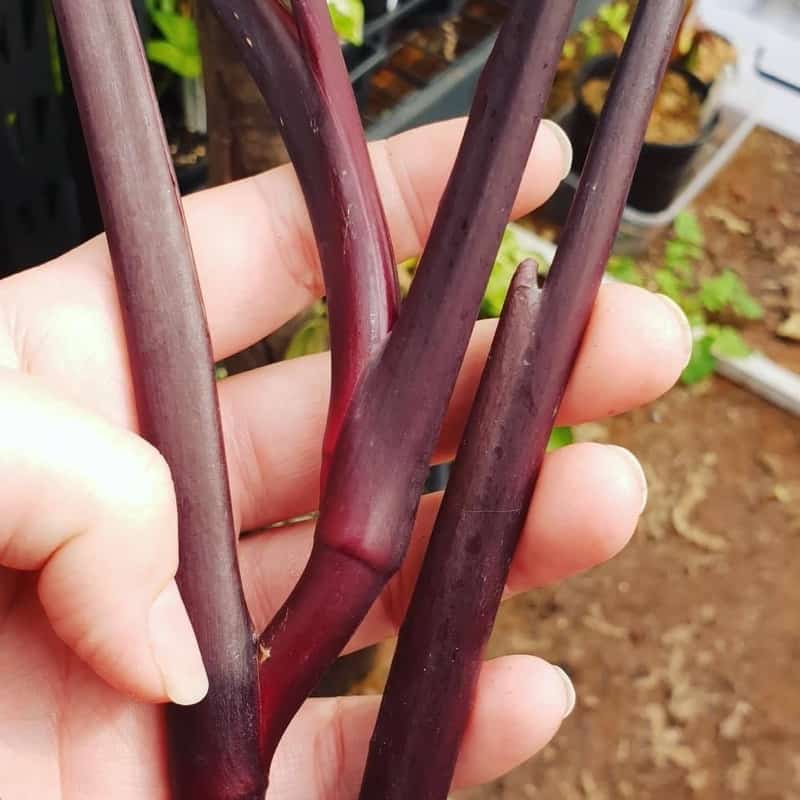
How to Propagate Philodendron Black Knight With Air Layering
Air Layering for propagation should only be used during the growing season.
- Snip a stem section that contains a node.
- Extra foliage should be removed from the stem and sliced into the stem.
- Wrap the wound with peat moss and soil and wrap it in plastic wrap. Tie the ends of the plastic closed to increase the humidity near the wound.
- When new roots appear, the plastic can be removed and cut just below the stem cutting with the new roots.
- Plant the new cutting with roots into potting soil.
Philodendron Black Knight Toxicity and Pets
Philodendron genus members are toxic to pets, including cats and dogs. According to ASPCA, the Philodendron Black Knight is toxic to our pets.
Philodendrons contain calcium oxalate crystals. The crystals are toxic to pets and humans. It’s best to keep this plant out of the reach of small children.
Calcium oxalate crystals can create respiratory problems, nausea, diarrhea, burning, and swelling when touched. The plant’s sap will cause skin irritation, as well as the mouth and throat.
Allergic reactions are not uncommon. Chewing, eating, or swallowing Philodendrons can contribute to kidney failure in pets.
Symptoms of Calcium oxalate crystal poisoning include:
- Vomiting
- Swelling lips, mouth, and tongue
- Swallowing problems
- Pawing at the face
- Nausea
- Mouth sores
- Loss of appetite
- Drooling
- Diarrhea
Upon discovery of philodendron ingestion, remove any pieces of the plant still in the mouth and rinse out your pet’s mouth.
The skin should be rinsed after direct contact with plant sap. Call your veterinarian in case of symptoms. If you observe severe symptoms, go to a pet emergency hospital as soon as possible for treatment.
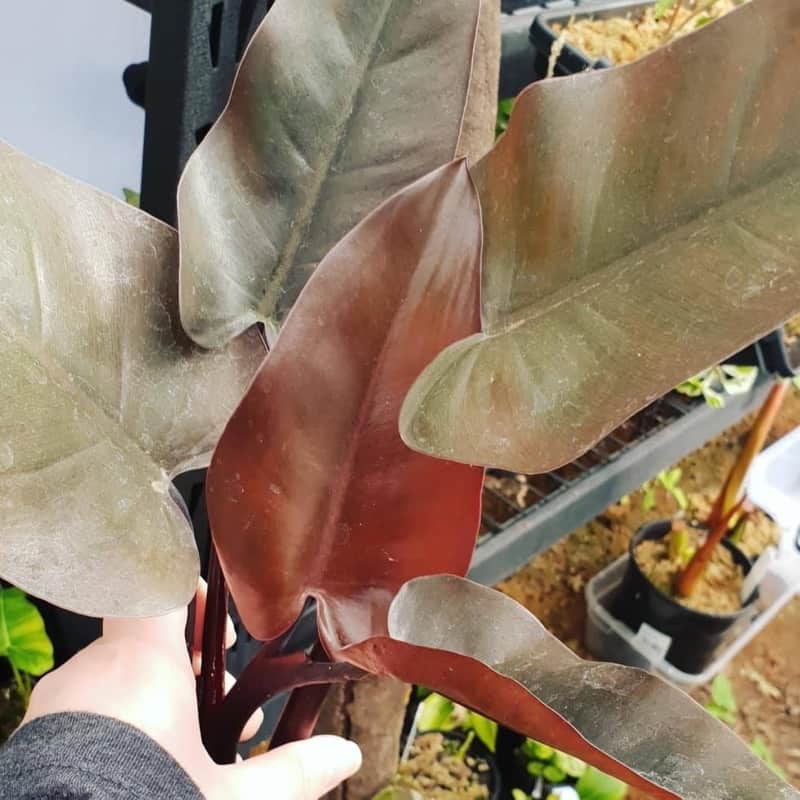
Philodendron Black Knight Pests, Diseases, and Problems
Since the Black Knight leaves are large, the leaves should be dusted so that your plant can photosynthesize. Dust on the large, oval leaves will prevent photosynthesis.
Brown Leaf Tips
Brown tips are usually a sign of underwatering. Dead foliage should be removed.
Brown spots on leaves can be a sign of bacterial or fungal infections, so investigate before treating your plant.
Pests
Pests are problematic for all houseplants, although philodendrons tend to be more pest-resistant than other houseplants. Plants should be checked for pests before being placed near other plants.
Common pests to watch for are:
Spider mites
Spider mites are attracted to dry soil conditions, so keeping the soil moist will help prevent them from taking up residence. Use insecticidal soap or neem oil to help get rid of the mites.
Mealybugs
Mealybugs are easily identifiable because they look like white cottony blobs on your plant. They, tend to hide in leaf joints and are sapsuckers. They will deplete a plant.
Remove any pests you can manually or blast a jet of water to remove them. Treat your plant with diluted organic neem oil spray and keep it isolated until it is free of pests.
Aphids
When new growth is stunted or damaged, aphids may have taken up residence in your plant. These tiny pear-shaped bugs with antennae can barely be seen by the naked eye. They can do some major damage to the plant though.
Once they take up residence, they reproduce and multiply rapidly. Aphids feed off the plant’s sap. Insecticidal soap or organic neem oil should resolve the problem.
Philodendron Black Knight Diseases
The most common Philodendron Black Knight disease is root rot. The primary cause is overwatering or insufficient drainage. Roots that end up sitting in water without proper aeration and access to oxygen will begin to rot.
To revive the Black Knight, follow these steps:
- Remove the plant from the waterlogged soil and trim away all mushy and damaged roots.
- Rinse off the remaining healthy roots and apply a fungicide.
- Repot the philodendron in a fresh potting mix. If you want to reuse the same pot as before, be sure to sterilize the container first to tet rid of remaining fungus traces.
- Wait several days to a week before watering again.
The Philodendron Black Knight is likewise at risk for bacterial and fungal infections. Overwatering is also generally the reason.
To help revive the Black Knight from an infection, follow these steps:
- Remove any infected plant parts including leaves, stems, and roots.
- Rinse the remaining healthy roots and apply a fungicide.
- Repot the philodendron in a sterilized pot with fresh potting mix.
- Wait to water for several days.
Philodendron Black Knight Final Thoughts
If you are looking for an exotic looking houseplant, consider the Philodendron Black Knight with its unique deeply hued foliage.
The dark burgundy, heart-shaped foliage almost appears black and will turn more than one head when cultivated in your home or office. It also makes a striking addition to an outside garden bed.
Check out these other philodendron plant care guides:
Image sources:
- https://www.facebook.com/ruraltropics/
- https://www.facebook.com/tinandnoelgardening/

